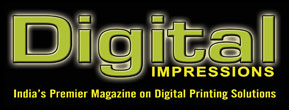The COVID-19 pandemic catalyzed a
seismic shift across industries,
compelling businesses to recalibrate
strategies and embrace digital
solutions at an accelerated pace. In
this transformative era, the printing
industry experienced a paradigm shift,
witnessing a rapid ascent in the
adoption of digital printing
technologies. The multifaceted growth
of digital printing in the post-COVID-19
era, unveiled the key drivers, pivotal
trends, and promising prospects that
have propelled its remarkable
expansion.
The pandemic-induced disruptions
reverberated throughout global supply
chains and manufacturing sectors,
significantly impacting traditional
printing methodologies. Conventional
printing methods reliant on large-scale
production and physical interactions
faced unprecedented challenges due
to lockdowns, material shortages, and
logistical constraints. This tumultuous
landscape nudged businesses towards
seeking agile, adaptable printing
solutions, thereby fueling a
pronounced surge in digital printing
adoption.
Digital printing emerged as a beacon
of resilience during the pandemic,
offering unparalleled flexibility, speed,
and customization capabilities
compared to conventional
counterparts. The technology’s intrinsic
capacity to facilitate short print runs,
personalized content, and on-demand
printing proved instrumental in meeting
the evolving demands of diverse
industries, encompassing advertising,
packaging, textiles, and publishing. Consequently, businesses swiftly
pivoted towards digital printing to
navigate the uncertainties and
disruptions of the pandemic era.
Technological advancements
powering growth advancements in
digital printing technologies have
played a pivotal role in driving its postpandemic
surge. Continuous
innovation in inkjet, laser, and 3D
printing technologies significantly
enhanced print quality, escalated
production speeds, and broadened the
spectrum of printable materials.
Moreover, the infusion of artificial
intelligence (AI) and automation
streamlined workflows, optimizing
operational efficiency and mitigating
costs for printing enterprises.
Several key factors have fueled the
meteoric growth of digital printing in
the post-COVID landscape. The
exponential rise of e-commerce
platforms spurred a burgeoning
demand for customized packaging,
underscoring the necessity for digital
printing’s adaptability and agility.
Additionally, the escalating emphasis
on sustainability and reduced
environmental impact aligned
seamlessly with digital printing’s ecofriendly
attributes, characterized by
minimal setup waste and the ability to
execute on-demand printing, thereby
curbing excess inventory.
Furthermore, the convergence of
digital printing with transformative
technologies, such as augmented
reality (AR) and the Internet of Things
(IoT), opened new frontiers for
interactive and personalized print
experiences. AR-enabled print
materials and IoT-connected packaging
not only augmented consumer
engagement but also furnished
invaluable data insights, propelling the
widespread adoption of digital printing
across diverse industries.
Digital printing empowered
marketers to craft highly targeted and
personalized campaigns tailored to
individual consumer preferences.
Variable data printing facilitated the
seamless integration of customized
content into promotional materials,
resulting in heightened engagement
and amplified conversion rates.
The textile sector underwent a
significant paradigm shift towards
digital textile printing. The technology’s
prowess enabled rapid prototyping,
bespoke customization, and minimized
waste. Its capabilities in rendering
intricate designs, vibrant hues, and
expediting production cycles met the
escalating demand for personalized
apparel and home textiles.
Customized packaging emerged as
a strategic differentiator for brands
seeking to stand out on crowded
shelves. Digital printing’s prowess in
delivering shorter lead times, costeffective
short runs, and the
incorporation of variable data
empowered brands to create
distinctive, visually captivating
packaging solutions, thus enhancing
brand identity and consumer appeal.
While the exponential growth of
digital printing in the post-COVID era
presents myriad opportunities, it also
entails certain challenges. The initial
capital investment in digital printing
technology and the imperative need for
skilled personnel proficient in operating
these advanced systems remain
formidable barriers, particularly for
smaller enterprises.
However, these challenges also
signify opportunities. Ongoing
technological advancements are
progressively driving down costs and
enhancing accessibility, rendering
digital printing increasingly attainable
for a broader spectrum of businesses.
Collaborative endeavors between
printing technology providers and
educational institutions are nurturing
the development of skilled
professionals, thus addressing the
critical need for a competent workforce
adept in harnessing these cutting-edge
technologies.
The trajectory of digital printing in the
post-COVID landscape portends
sustained growth and relentless
innovation. The fusion of digital printing
with emerging technologies, such as
nanotechnology, and its further
integration with AI and machine
learning, are poised to revolutionize the
industry. Additionally, the unwavering
emphasis on sustainability will propel
the development of eco-friendly
printing solutions, solidifying digital
printing’s position as a linchpin driving
industry metamorphosis.
The COVID-19 pandemic acted as a
pivotal inflection point, accelerating the
adoption and evolution of digital
printing across multifarious sectors.
The technology’s inherent versatility,
speed, and customization capabilities
perfectly aligned with the dynamic
market dynamics, catapulting its
exponential growth. As digital printing
continues to evolve and innovate, it
stands poised to redefine the future of
printing, offering an array of
unparalleled opportunities for
businesses to thrive in an increasingly
dynamic, digital-centric landscape. |

